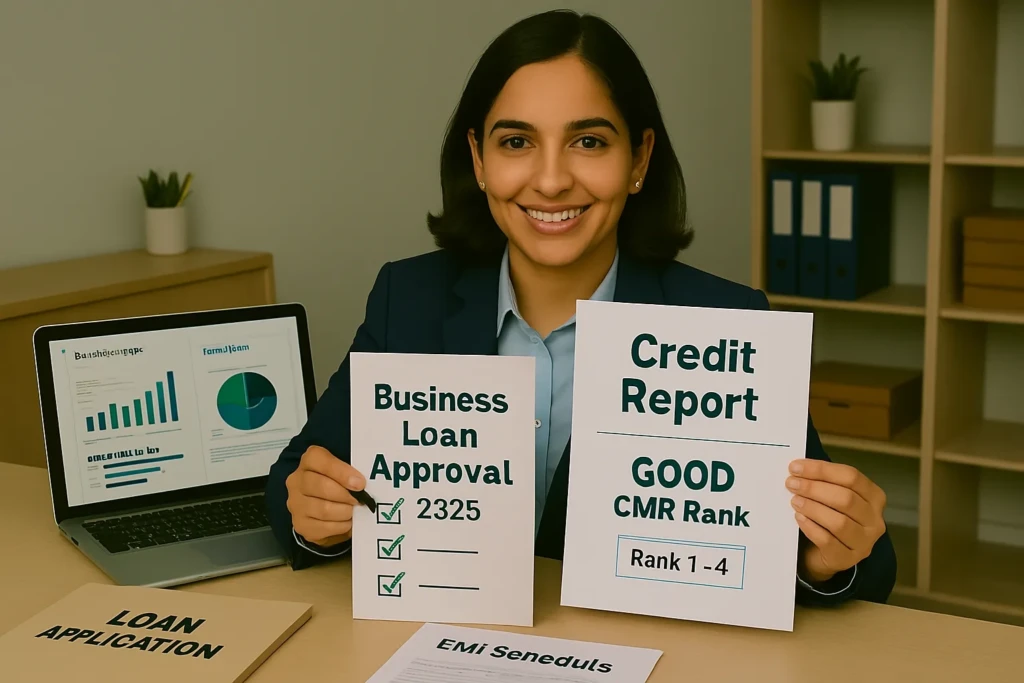Applying for a business loan in 2025? You’ll need more than just turnover and tax returns — you need to clear the lender’s credit filters. One of the most important? Your CIBIL MSME Rank (CMR Rank).
With rising loan defaults and digital underwriting models, banks and NBFCs now rely heavily on CMR Rank and your Company Credit Report (CCR) to approve or reject applications.
In this blog, you’ll find a complete, updated checklist to qualify for MSME or business loans in 2025, focusing on CMR Rank requirements, documentation, and smart tips that banks won’t tell you.
🧾 What is CMR Rank and Why It’s Non-Negotiable in 2025
CMR (CIBIL MSME Rank) is a credit rank from 1 to 10 assigned to your business by TransUnion CIBIL.
-
CMR-1 to CMR-4: Safe for lending
-
CMR-5 to CMR-6: Moderate risk — limited approval
-
CMR-7 to CMR-10: High risk — mostly rejected
-
CMR-NA/NH: No data — ineligible in most cases
Lenders use this rank to decide interest rate, loan amount, and whether to approve your business loan application.
🔗 Related: How to Improve CIBIL Rank in 90 Days
✅ MSME Business Loan Eligibility Checklist (with CMR Rank Focus)
Here’s your 2025-ready checklist to qualify for any MSME/business loan from Indian lenders.
1. Company Credit Report (CCR) Must Be Clean
✅ Pull your latest CCR from CIBIL:
https://www.cibil.com/company-credit-report
☐ No overdue EMIs
☐ No loan settlements or write-offs
☐ DPDs (Days Past Due) must be zero for last 6 months
☐ PAN, business name, contact details updated
☐ Credit utilization under 60%
🧠 Tip: Raise errors through the CIBIL Dispute Portal
2. CMR Rank Between 1 and 4
☐ Your latest rank should be CMR-4 or better
☐ Rank should not be NA (no credit activity = low trust)
☐ CMR issued within the last 3 months
📉 A CMR-6 or higher (e.g. CMR-7, 8, 9) often leads to:
-
Rejection of unsecured loans
-
Higher interest rates (up to 5% more)
-
Loan amount reductions
3. Minimum 12 Months of Active Credit History
☐ You should have at least one active loan or OD/CC for over 12 months
☐ Closed loans should show proper “closed” status in the CCR
☐ No “settled” accounts — they destroy your CMR
🔗 Learn: Credit Utilization and Rank – Investopedia
4. Low Credit Utilization
☐ If you have OD or CC limit — usage should be under 50%
☐ Overdrawing or full-limit use affects your CMR badly
☐ Maintain minimum balance to avoid auto-debits failing
🧠 Bonus: Request a higher credit limit, but don’t use it — this improves utilization ratio and positively impacts your CCR.
5. No Recent Multiple Inquiries
☐ Don’t apply to multiple banks within short span (15–30 days)
☐ Avoid “DSA Shopping” where you send your documents to 10+ agents
☐ Each credit inquiry adds a hard pull in your CCR, which drops your CMR rank
🔗 RBI Guidelines on Fair Practices Code
6. Healthy Financial Documents
☐ GST filed up to date (past 12 months)
☐ Minimum ₹20–30 lakh annual turnover (depending on product)
☐ ITR filed for last 1–2 years
☐ Bank statement with positive balance and cash flow pattern
Banks now use AI to match your bank statement with CCR behavior. Even one mismatch can lead to rejection.
7. No Co-Obligations or Guarantees with Defaults
☐ If you are a guarantor on someone else’s loan, their default affects your CMR
☐ Remove your name from any risky loan guarantees
☐ Avoid taking co-loans unless you control the payment behavior
8. Business Vintage & Profile
☐ Minimum 1–3 years in operation
☐ Must be registered under Proprietorship, LLP, Pvt Ltd, etc.
☐ Address and PAN must match CCR entries
☐ Industry should not fall under high-risk category (as per bank matrix)
🧠 Note: Retail, construction, and unregistered businesses often face extra scrutiny.
🧠 Lender Tip: What Banks Check Behind the Scenes
| Parameter | Checked By | Impact |
|---|---|---|
| CMR Rank | All lenders | Determines eligibility |
| CCR Report | Credit bureaus | Risk profile + payment behavior |
| GST/ITR | Underwriters | Turnover verification |
| Bank Statement | AI models | Daily cash flow and inflow pattern |
| PAN & Aadhaar | KYC validation | Fraud check |
| Udyam/GST Registration | Policy filter | Eligibility criteria |
⚠️ Common Mistakes That Disqualify Your Loan Application
-
Settling an OD or loan — instead of paying it off
-
Ignoring incorrect CCR data
-
Having a good CIBIL Score, but no CMR Rank
-
Having PAN errors in your CCR
-
Submitting applications to many lenders at once
🔗 Must-read: Common CIBIL Rank Mistakes and How to Fix Them
📑 Quick CMR-Based Loan Readiness Checklist (Print-Friendly)
| Checkpoint | Status |
|---|---|
| CCR pulled and reviewed | ☐ |
| CMR Rank between 1–4 | ☐ |
| No DPDs or overdue entries | ☐ |
| OD/CC utilization < 50% | ☐ |
| GST, ITR, bank statements updated | ☐ |
| No recent loan inquiries | ☐ |
| Business is 1–3 years old | ☐ |
🧠 FAQs: Business Loan & CMR Rank in 2025
1. Is CMR Rank more important than CIBIL Score for MSMEs?
Yes. CIBIL Score is for individuals, while CMR Rank reflects your business’s creditworthiness.
2. What CMR Rank is required for unsecured MSME loans?
Most lenders require CMR-1 to CMR-4. Some accept up to CMR-5 with strong documents.
3. Can I qualify with CMR-6 or CMR-7?
You may qualify for a secured loan or NBFC-funded loan, but rates will be higher and limits lower.
4. Can I improve my CMR Rank fast?
Yes. By clearing dues, fixing CCR errors, and managing credit wisely, it’s possible to improve CMR within 60–90 days.
5. Where can I check my CMR Rank?
Visit CIBIL’s Company Credit Report page and request your CCR with CMR included.




